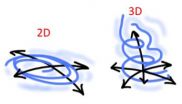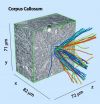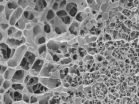(Press-News.org) Turbulent flows have challenged researchers for centuries. It is impossible to predict chaotic weather more than a week in advance. Wind resistance on a plane or a car cannot be calculated precisely, since it is determined by atmospheric turbulence. Now, however, researchers from the Niels Bohr Institute have succeeded in developing a statistical model that can replicate the chaotic flows and thereby provide a better understanding of the process. The research results are published in the scientific journal, Physics of Fluids.
"Without knowing the movements in detail, we know that they happen in such a way that the kinetic energy is conserved," explains Peter Ditlevsen, a research associate professor at the Niels Bohr Institute at the University of Copenhagen. He explains that when a liquid or air is set in motion, for example, if you create large eddies in a bathtub by stirring the water, it will transpire, that when you stop stirring, smaller and smaller eddies will continue to be created, while the large ones slowly die out. Finally, the movement in the smallest eddies are converted into heat. The entire process is called an energy cascade from large scales to small scales and is absolutely fundamental for understanding chaotic turbulent flow.
If the motion is limited to only being able to take place on a single plane, that is, two dimensions (2D), instead of in a volume, that is, three dimensions (3D), it will happen quite differently. The reason is that the flow cannot release its energy as small eddies cannot easily be formed in two dimensions. In two dimensions, both the energy and eddy density (which is called enstrophy) is retained in the flow, unlike in three dimensions, where only the energy is preserved.
Complicated calculations in 3D
A complex motion equation that has been known for almost 200 years, the so-called Navier-Stokes equation, is used to calculate the air's turbulent 3D movements. But even the world's most powerful computers, which have been dedicated to just this purpose, can only provide an approximate solution to the equation.
In order to describe the turbulent cascade processes, the researchers have therefore developed simplified mathematical models that are much easier to fully investigate in with computer calculations. The models have the same behaviour as the Navier-Stokes equation, but the models have not been able to reproduce the so-called inverse cascade in 2D.
Until now, the models have been too limited to show both the eddy density cascades down to small scales and the energy cascades up to large scales. They have been able to simulate the one cascade or the other, but not both simultaneously.
Simpler calculations in 2D
However, Peter Ditlevsen has now succeeded in developing such a cascade model that can reproduce the double cascade process in 2D turbulence.
"Turbulence can occur as a somewhat exotic phenomena. Though not in this case: Motion in the atmosphere, the wind and the weather is largely two-dimensional. The movements on the vertical axis are 100 to 1000 times less than those on the horizontal axis. The air has a much more difficult time moving vertically, so the movement of the weather systems movement is two-dimensional turbulence. This means that it is possible to predict the weather a ways ahead of time. If the movement had been three-dimensional, it would be dominated by small eddies, which are completely unpredictable, like when you see autumn leaves randomly floating around in a courtyard," explains Peter Ditlevsen.
The turbulent flows occur over a vast span of scales, so when researchers want to understand the processes, they have to study simplified models.
"With the new model of the two-dimensional turbulence we are one step closer to understanding which factors in the motion equations govern how energy is distributed in the flow," explains Peter Ditlevsen.
INFORMATION:
Article in Physics of Fluids:
http://pof.aip.org/resource/1/phfle6/v24/i10/p105109_s1?bypassSSO=1
For more information contact:
Peter Ditlevsen, Associate professor in geophysics and climate modelling, Centre for Ice and Climate, Niels Bohr Institute, University of Copenhagen, +45 3532-0603, +45 2875-0603, pditlev@nbi.ku.dk
http://www.nbi.ku.dk/english/
Turbulent flows in 2D can be calculated in new model
2012-10-23
ELSE PRESS RELEASES FROM THIS DATE:
Quantum computing with recycled particles
2012-10-23
A research team from the University of Bristol's Centre for Quantum Photonics (CQP) have brought the reality of a quantum computer one step closer by experimentally demonstrating a technique for significantly reducing the physical resources required for quantum factoring.
The team have shown how it is possible to recycle the particles inside a quantum computer, so that quantum factoring can be achieved with only one third of the particles originally required. The research is published in the latest issue of Nature Photonics.
Using photons as the particles, the Bristol ...
A circuit diagram of the mouse brain
2012-10-23
This press release is available in German.
What happens in the brain when we see, hear, think and remember? To be able to answer questions like this, neuroscientists need information about how the millions of neurons in the brain are connected to each other. Scientists at the Max Planck Institute for Medical Research in Heidelberg have taken a crucial step towards obtaining a complete circuit diagram of the brain of the mouse, a key model organism for the neurosciences. The research group working with Winfried Denk has developed a method for preparing the whole mouse ...
Lung mucus gel scaffold prevents nanoparticles from getting through
2012-10-23
Mucus coats our airways' internal surfaces. The viscous gel humidifies the lungs and prevents viruses and other small particles like diesel soot from entering the body unchecked. Previously unclear was the extent to which such nanoparticles are able to move through the lungs' mucus. Here, the research evidence was contradictory. Scientists could not explain why, in inhaled medication development, drug nanoparticles often simply got stuck in the mucus never making it to their target destination inside the lung cells.
Now, as part of a German Research Foundation (DFG)-funded ...
The complex association between moderate alcohol consumption and breast cancer
2012-10-23
An excellent review article from two scientists at the National Institute on Alcohol Abuse and Alcoholism in the USA to be published in Alcohol Clin Exp Res 2012, describes the epidemiologic and basic scientific evidence linking alcohol consumption to the risk of breast cancer.
The authors point out deficiencies in the epidemiologic data, especially that the pattern of drinking (regular moderate versus binge drinking) has generally not been taken into consideration, important given that binge drinking is associated with much higher blood alcohol concentrations and acetaldehyde ...
TIM and TAM: 2 paths used by the Dengue virus to penetrate cells
2012-10-23
By demonstrating that it is possible to inhibit the viral infection in vitro by blocking the bonding between the virus and these receptors, the researchers have opened the way to a new antiviral strategy. These works were published on line in the review "Cell Host & Microbe" of October 18, 2012.
The Dengue virus circulates in four different forms (four serotypes). It is transmitted to humans by mosquitoes. It is a major public health problem. Two billion people throughout the world are exposed to the risk of infection and 50 million cases of Dengue fever are recorded by ...
19 species of ferns named for Lady Gaga
2012-10-23
DURHAM, N.C. -- Pop music megastar Lady Gaga is being honored with the name of a new genus of ferns found in Central and South America, Mexico, Arizona and Texas. A genus is a group of closely related species; in this case, 19 species of ferns will carry the name Gaga.
At one stage of its life, the new genus Gaga has somewhat fluid definitions of gender and bears a striking resemblance to one of Gaga's famous costumes. Members of the new genus also bear a distinct DNA sequence spelling GAGA.
Two of the species in the Gaga genus are new to science: Gaga germanotta from ...
Moffitt researchers study how patterns, timing of sunlight exposure contribute to skin cancers
2012-10-23
Researchers at Moffitt Cancer Center, the University of South Florida and the International Agency for Research on Cancer in France have studied the patterns and timing of sunlight exposure and how each is related to two nonmelanoma skin cancers – basal cell carcinoma and squamous cell carcinoma.
This study, published in the open-access journal BioMed Central, is the first case-control study to simultaneously evaluate identical patterns and timing of sunlight exposure as they are related to basal cell and squamous cell carcinomas in the same U.S. population with high ...
Vanderbilt researchers find that diabetes drug could be effective in treating addiction
2012-10-23
Vanderbilt researchers are reporting today that a drug currently used to treat type 2 diabetes could be just as effective in treating addiction to drugs, including cocaine.
The findings, published online today as a Letter To The Editor in the journal Molecular Psychiatry, could have far-reaching implications for patients worldwide who suffer from addiction.
"What we have demonstrated is that a brain mechanism already known to be therapeutic for the treatment of diabetes also appears to be implicated in at least certain types of drug addiction," said Gregg Stanwood, ...
New American Chemical Society videos celebrate 25 years of National Chemistry Week
2012-10-23
WASHINGTON, Oct. 23, 2012 — The American Chemical Society (ACS) today released two new videos celebrating the 25th Anniversary of National Chemistry Week (NCW). The videos, from the world's largest scientific society, coincide with the start of this year's NCW, being observed in hundreds of communities around the country. Both videos are available now at www.BytesizeScience.com.
One video is a new episode of ACS' award-winning Bytesize Science series. It highlights research behind this year's NCW theme — nanotechnology. The second video is a retrospective on the history ...
Engaging parents leads to better treatments for children with adhd
2012-10-23
Philadelphia, October 23 Pediatricians and researchers at The Children's Hospital of Philadelphia's(CHOP) have developed a first-of-its kind tool to help parents and health care providers better treat ADHD (attention deficit-hyperactivity disorder). The new, three-part survey helps steer families and doctors toward "shared decision-making", an approach proven to improve healthcare results in adults, but not widely used in pediatric settings. The results of the CHOP study are published in the journal Academic Pediatrics.
"Shared decision-making in health care means ...


